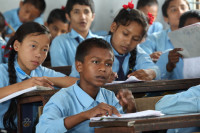Opinion
Doing much with little
Despite limited resources and political instability, Nepal is doing well on health, social indicators
Jaya Lamichhane
Let me begin with good news for India, who ranks 135th on the Human Development Index (HDI), whereas Nepal ranks 145th. The HDI uses three variables—health (life expectancy at birth), education (expected years schooling for school-age children and average years of schooling in the adult population), and income [measured by Gross National Income (GNI) per capita (purchasing power parity in USD)], according to UNDP. Among these variables, there is not much difference in health and education for both countries. Nepal is doing slightly better in health while India is doing better in education. However, there is a significant difference in terms of income. India’s GNI per capita is $5,150, which is more than twice the per capita income of Nepal. Long standing political instability and a decade-long insurgency have been the primary reasons behind this low income.
But coming from a public health background, I thought of comparing and analysing the health indicators of both countries. For illustration, I have used a table with a number of indicators—service coverage, service delivery, quality care, and outcomes of these services. All data used in this article are either from the World Health Organisation, Unicef, or UNDP, which are UN agencies and
purportedly neutral.
Comparing health
On indicators for service coverage, delivery, and outcome, Nepal is doing better than India, with more people living longer and more children surviving after birth. Interestingly, the proportion of survival of pregnant mothers are the same for both countries (170 per 100, 000 live births). Nonetheless, if we do some analysis based on investment, efficiency, and effectiveness of the maternal health programme in both the countries, then this figure should be considered better for Nepal. The contraceptive prevalence rate, proportion of skilled birth attendants, and density of physicians per 10,000 population are higher for India than in Nepal. But despite low levels of service delivery and capacity, Nepal has managed to have the same proportion of antenatal care visits and maternal mortality ratio as India. Obviously, these are the signs of efficiency, effectiveness, and the delivery of quality care despite obstacles.
Trust in Nepal’s health services remains high, as even Indians residing in the border districts and states frequently cross into Nepal for various healthcare services, like eye care, vaccinations, and Vitamin A supplements. Nepal is also doing better with higher immunisation and Vitamin A supplement coverage; the number of people dying from malaria is significantly lower; fewer children are underweight; fewer children of low birth weight are born; and more children are exclusively breast-fed in Nepal.
Similarly, although India’s Gross Domestic Product (GDP) and/or Gross National Income (GNI) is higher, Nepal spends more on health and has more hospital beds available in the country, despite having fewer physicians in proportion. In a nutshell, Nepal is doing far better, especially given the difficult circumstances it has been operating under.
Doing better socially
If health indicators are deemed insufficient, let me illustrate my argument with some indicators in education and the Human Development Report. India’s adult literacy rate is higher than that of Nepal; however, the literacy rate of female youth is higher in Nepal. More people in India stay in school than in Nepal; however, there are less homeless people in Nepal than in India. Similarly, though we don’t have enough resources, the employment ratio is higher than that of India.
When it comes to social indicators, gender equality is far better in Nepal with an almost equal sex ratio, better female representation in Parliament, and almost no reports of female foeticide than those of India. When it comes to poverty, the proportion of the population below the poverty line is higher in Nepal; however, if we look at the multidimensional poverty index (MPI), it is less than that of India. According to UNDP, the MPI identifies multiple deprivations at the household and individual level in health, education, and standard of living.
True, there are many indicators/indices for economic and social development where India is doing far better than Nepal and I believe that the development of our neighbours will assist development in the region. But India has not been able to cash in on its demographic bonus, more than a billion people, and massive resources for rapid economic growth. Nepal, despite political instability, a decade-long insurgency, and geographic hindrances, is still managing to do well on social indicators.
Learning from the little guy
For an analogous example, just look at Cuba. Despite being at odds with the world’s biggest superpower, which has long had sanctions against Cuba, their health indicators are comparable with some of the most developed countries in the world. But I have yet to hear anyone disparaging Cuba’s health indicators. Instead, many public health schools like Harvard, Johns Hopkins, and Yale use Cuba, Sri Lanka, and India’s Kerala as examples of doing well in health and education despite limited resources.
Similarly, Nepal has set an example of achieving Millennium Development Goals (MDGs) and gender equity despite many impediments. Nepal can openly share its strategies and efforts, ‘even’ though we are going through difficult times of
political instability and uncertainty.
Lamichhane is a public health specialist based in Jakarta, Indonesia




 8.12°C Kathmandu
8.12°C Kathmandu










